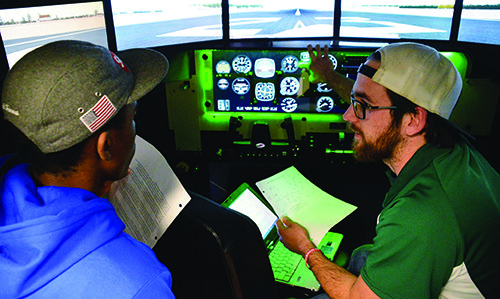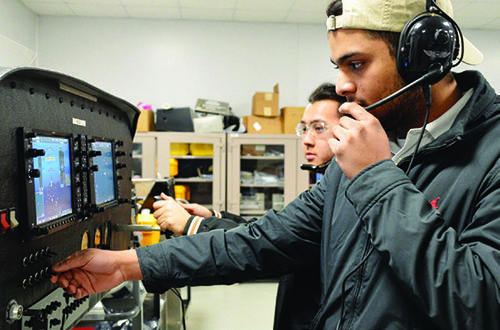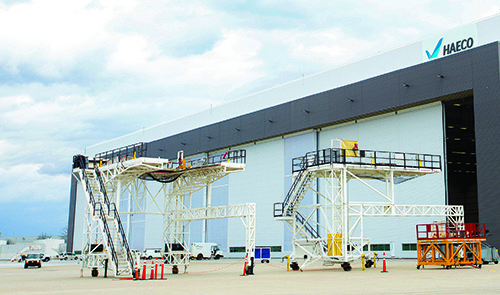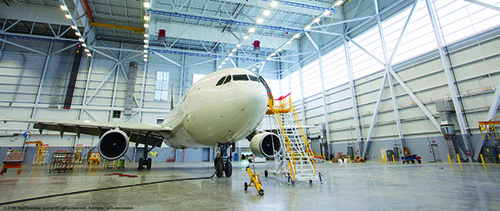Like the youngest brother who grows up in a family of star athletes, Piedmont Triad International Airport (GSO) is used to being overshadowed by its bigger North Carolina brethren. With approximately 1.7 million annual passengers, it serves a fraction of the traffic handled at Raleigh-Durham International and Charlotte Douglas International.
Like the youngest brother who grows up in a family of star athletes, Piedmont Triad International Airport (GSO) is used to being overshadowed by its bigger North Carolina brethren. With approximately 1.7 million annual passengers, it serves a fraction of the traffic handled at Raleigh-Durham International and Charlotte Douglas International (about 11.6 million and 46 million annual passengers, respectively).
But little brothers ultimately grow up, establish their own identity and make headlines of their own. GSO has certainly done so.
Located in central North Carolina, GSO is the centerpiece of an area that has grown into an aerospace hotspot. Over the last two decades, the area has become a prominent U.S. hub for aircraft manufacturing, aircraft parts supply, and maintenance, repair and overhaul facilities.
|
facts&figures Project: Landside Development Location: Piedmont Triad (NC) Int’l Airport Major Tenants: FedEx; Honda Aircraft; Cessna; HAECO Americas Local Impact: Aerospace industry contributes $5.9 billion/yr to local economy; about 17,700 local residents work for large aerospace firms or companies that support them Airport Land Available for Development: 1,000 acres Development Strategies: Control growth; lease land strategically to preserve large parcels for future tenants Of Note: Guilford Technical Community College provides trained workers for local aerospace companies |
Local Economic Driver
The Piedmont Triad of Greensboro, High Point and Winston-Salem is home to more than 50 aerospace companies that employ 5,700 people. Kevin Baker, executive director of Piedmont Triad Airport Authority, notes that economic impact studies indicate another 12,000 people in the region work for companies directly related to the aerospace industry. Together, these businesses are estimated to infuse $5.9 billion into the local economy each year.
“I call us the Sesame Street airport, because we’re the one that’s not like the others,” Baker quips. “Our first mission is to provide the best possible passenger experience we can, but we are not entirely focused on the transportation mode that most airports focus on.”
Prominent aerospace businesses that have located at GSO include FedEx, Honda Aircraft Company, Cessna and HAECO Americas, which manufactures aircraft interior products and provides aircraft maintenance, repair and overhaul services.
Baker estimates that up to three-fourths of his job is working with businesses that have established operations at GSO, as well as recruiting additional companies to fill the 1,000-plus acres of airport property that remain available for development. “About six or seven years ago, the airport identified that the aerospace industry is doing nothing but growing, so we planned ahead to be able to always say ‘yes.’ If a company needs interstate access and 100 acres next to a runway—and they need it next week—we are ready to say yes,” Baker says.
Based on the current ratio of employees to existing companies, Baker projects that as GSO continues to attract businesses, the total number of workers in the Piedmont Triad region who work for an aerospace-related company could hit 30,000. That’s increasingly significant, given that the median household income in the region is $47,026 and the average salary at a company like Honda Aircraft is $75,000.
“These are good jobs that are adding to the local economic base and raising that tide,” he says. “We want to make sure that we can always have those types of companies here.”
Controlled Growth
After working as a civil engineer and aerospace consultant for two decades, Baker accepted the deputy director position at the airport authority in 2008, and took the lead role in 2010. He has emphasized controlled growth during his tenure, and plans to continue doing so. Baker has had conversations with two aircraft manufacturing companies that are considering establishing facilities at GSO, but he could not reveal their identities.
 “We can support a whole lot of economic growth, but it has to be done the right way. We have detailed plans on how that will happen in an orderly fashion. It will never work out like that because I’m never that lucky,” he jokes. “But we’ve got contingency plans. You don’t want a smaller company to drop 20 acres in the middle of 1,000 because it may ruin your larger site.”
“We can support a whole lot of economic growth, but it has to be done the right way. We have detailed plans on how that will happen in an orderly fashion. It will never work out like that because I’m never that lucky,” he jokes. “But we’ve got contingency plans. You don’t want a smaller company to drop 20 acres in the middle of 1,000 because it may ruin your larger site.”
Local and state governments are helping make the region an attractive home for businesses. For instance, significant investments are being made to improve the interstate highway network adjacent to GSO, which will create easy access to/from industrial sites around the airport. Major highways such as I-40, I-85 and I-74 are already in place, with connectors under construction and coming online in the near future. The network will be complete by the end of this year, opening up numerous additional opportunities for industrial sites with immediate interstate highway access.
North Carolina Department of Transportation, the city of Greensboro and Guilford County all contributed financially to the recent construction of a state-of-the-art hangar by HAECO Americas. (See sidebar)
Filling the Worker Pipeline
One of the biggest attractions to the Piedmont Triad region for aerospace companies is the talent-feeding system provided by Guilford Technical Community College (GTCC). The school offers five separate degree programs related to aerospace jobs, plus continuing education courses for aerospace professionals. It also provides custom training for aerospace companies in the region.
The looming pilot shortage that is expected to affect the worldwide aviation industry has been well-publicized. Lesser-known, however, is the current shortage of aerospace mechanics. Nicolas Yale, director of the aviation programs at GTCC, says the pipeline thinned after 9/11 due to airline consolidation and an industrywide downturn.

GTCC enrolls about 500 students in its aerospace programs, and most are from the region. Yale reports that local and national aerospace companies hit campus with job offers in hand before students even graduate.
“They’re all fighting for that one person they need,” he explains. “I tell students coming in that there are no guarantees in life. But if you finish any one of these programs, you’ll be employed.
“We’ve had companies recruiting out of our classrooms before they’re done. I’ve actually had to push back at them a little bit and say, ‘Let them finish their degree.’ The one or two companies that show up first grab all of them, and I have to tell the other businesses that our students are all hired.”

Symbiotic Relationship
GTCC has been part of the community for more than four decades. It opened the T.H. Davis Aviation Center at the airport in 1989 to replace a smaller facility that had been in operation since 1970. The facility has 36,000 square feet of classroom/lab space and a 12,000-square-foot hangar that was renovated in 2016. Currently, it houses eight aircraft, a helicopter and more than 20 system trainers for the various labs. It also has dedicated shops for engines, welding, composites, electrical components and sheet metal finishing.
Richard Kendall, chief executive officer of HAECO Americas, says GTCC is a critical contributor to its work force and one reason the maintenance, repair and overhaul provider located its North American headquarters at GSO. “If you read any articles about airplane maintenance in North America, virtually everyone mentions the shortage of qualified, experienced manpower. That’s a problem we share with the rest of the industry,” he laments.
HAECO Americas, a subsidiary of Hong Kong Aircraft Engineering Company, partners with GTCC to develop training programs for its mechanics’ certification. Yale says many companies in the area rely on the community college for customized training programs. Some last just a week, others are 10 weeks long.
Yale, a former avionics technician himself, is grateful for the symbiotic relationship the school and the local aerospace industry have established. Furthermore, he says the industry as a whole needs to expand its efforts with schools like GTCC to increase enrollments, or companies will continue to scramble for skilled workers. It’s a win-win opportunity that can increase enrollments and halt the escalating salaries that aerospace companies must offer to recruit and retain the best workers, explains Yale.
“Most colleges and technical schools do not have deep pockets for recruitment and advertising, plus many have restrictions on where they can recruit. If the industry joined them in this effort, the payoff would be on both sides and the cost would likely be lower than fighting in the open market. But the payoff has a time delay they have to get used to,” Yale advises.
Not surprisingly, Baker is a big proponent of increased coordination between GTCC and the companies that rely on local graduates to fill their payrolls. “The companies doing this kind of work—whether it’s building an airplane like Honda, or maintaining them, like HAECO or Cessna—need these employees. There are probably 20 to 25 cities in the U.S. that have the kind of bench strength in that industry that we have here. Having the machine that is perpetually creating new employees to be able to work in these businesses cannot be understated. That’s a key to everything.”
$60 Million Hangar Features Function, Sustainability & Style
|
|
facts&figures Project: New Hangar Location: Piedmont Triad (NC) Int’l Airport: Tenant: HAECO Americas Size: 250,000 sq. ft., with 176,000 sq. ft. of open floor space Capacity: Fits up to 8 next-generation, narrow-body aircraft or 2 next-generation, widebody aircraft & 2 next-generation, narrow-body aircraft Est. Cost: $60 million Funding: $4 million from NC Dept. of Transportation; $400,000 each from city of Greensboro and Guilford County; HAECO Americas funded rest Architect: BRPH Conceptual Design: Ghafari Associates Design-Build Contractor: BE&K Building Group Translucent Wall: Exterior Technologies Hangar Doors: NORCO Industrial Doors |
HAECO Americas, which provides aircraft maintenance, repair and overhaul services and related products, established its North American headquarters at GSO when the company purchased the facility from a hedge fund in 2014. (The company, previously known as TIMCO, was founded by local owners in 1990.) More recently, however, the company wanted to expand its services and knew that a larger hangar was necessary.
The result is a 250,000-square-foot state-of-the-art structure that was ready for use last January. The spacious hangar can accommodate up to eight next-generation narrow-body aircraft, or two next-generation wide-body aircraft and two next-generation narrow-body aircraft. It is the largest hangar at HAECO Americas’ facilities—almost twice the size of each of the other four hangars the company currently operates at GSO.
HAECO began working with Ghafari Associates on the conceptual design and contractor selection in August 2016. The design-build team included BRPH as the architect of record and BE&K Building Group as the design-build contractor.
The finished hangar earned silver level certification by the U.S. Green Building Council’s Leadership in Energy and Environmental Design (LEED) rating system. One of its signature features is an energy-efficient translucent wall that contributes to the building’s aesthetic, performance and sustainability goals.
“Sustainability is something we specified when we started the project,” says Richard Kendall, chief executive of HAECO Americas.

The Lightwall, by Exterior Technologies, provides extensive light transmission and capitalizes on naturally available daylight to reduce the demand—and associated costs—of electric lighting. The company markets the translucent wall as a modern, durable and economical solution for building envelopes that works especially well for hangar doors.
Total construction cost for the hangar is estimated at $60 million. HAECO Americas received a $4 million grant from the North Carolina Department of Transportation, which was mainly used for grading work prior to construction, plus $400,000 each from the city of Greensboro and Guilford County, where GSO is located. HAECO Americas funded the remainder of the project.
Piedmont Triad Airport Authority leases the land to HAECO Americas. “The public body has to own the land and any improvements there,” explains Kevin Baker, executive director of the authority. “We own it on paper, and they have rights to its use for 50 years.”

Official ownership notwithstanding, Baker is confident leaving execution of the hangar project in the hands of HAECO Americas and its partners. “The way I look at it is if they’re proud enough to put their name on the building, I’m confident that I’ll be proud to have it on our airport property,” he remarks.
 Operational flexibility was key for HAECO Americas. “It has a large floor area with minimal obstructions. We can get two or three wide-bodied aircraft plus a number of narrow-bodied aircraft in at one time,” reports Kendall. “It’s vital for us to be able to move people between different aircraft in different spaces as flexibly as possible. Also, being able to have as many aircraft under one roof as possible increases that operational flexibility and efficiency.”
Operational flexibility was key for HAECO Americas. “It has a large floor area with minimal obstructions. We can get two or three wide-bodied aircraft plus a number of narrow-bodied aircraft in at one time,” reports Kendall. “It’s vital for us to be able to move people between different aircraft in different spaces as flexibly as possible. Also, being able to have as many aircraft under one roof as possible increases that operational flexibility and efficiency.”
While narrow-bodied aircraft are the bread and butter of domestic traffic in the United States, HAECO Americas wanted to make sure it had the capacity for wide-bodied aircraft such as the Boeing 777 and Airbus A-350 as the market for larger airplanes emerges.
HAECO Americas services commercial and cargo airplanes, as well as U.S. Air Force aircraft. At full capacity, the new hangar is expected to employ 500 aircraft technicians and support staff, bringing the company’s total workforce at its GSO facilities to approximately 2,200 people.



